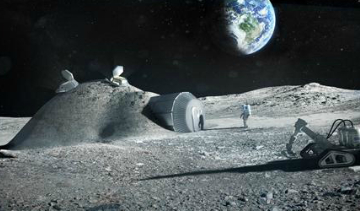
Architecture firm, ESA to explore 3D printing a moon base
By Design Engineering Canada
CAD/CAM/CAE 3D printing“Moon dust” build material to save cost of launching construction supplies.
The idea of erecting structures on the moon has been kicking around science fiction literature for decades but, aside from the technical difficulties, the galactic-scale costs associated with transporting mass amounts of building material to the lunar surface has made constructing a moon base unrealistic.
UK-based architecture firm, Foster + Partners, thinks it may have an answer. The company recently announced that it’s partnering with the European Space Agency to look into the possibility of 3D printing a lunar habitation by using lunar dust, or regolith, as the build material. According to Foster + Partners, the structure would be suitable for up to four people while providing protection from meteorites, gamma radiation and high temperature fluctuations.
The proposed plan calls for a tubular module connected to an inflatable dome to be transported to the lunar surface and set up as the support structure. According to the structure’s designers, ‘catenary’ dome is composed of a foam-like closed-cell structure so it remains light but can bear the weight of the moon dust while protecting against micrometeoroids.
 Layer by layer, a robotic D-Shape 3D printer, supplied by Monolite UK, would then cover the structure with regolith to create a protective shell. According to Monolite founder, Enrico Dini, the lunar dust is first mixed with magnesium oxide to create a slurry that is then hardened into a stone-like solid with a binding salt.
Layer by layer, a robotic D-Shape 3D printer, supplied by Monolite UK, would then cover the structure with regolith to create a protective shell. According to Monolite founder, Enrico Dini, the lunar dust is first mixed with magnesium oxide to create a slurry that is then hardened into a stone-like solid with a binding salt.
To test the concept, the company and its consortium partners used simulated lunar soil and a supplied D-Shape printer to build a 1.5 ton building block in a vacuum chamber to approximate lunar conditions. The planned site for the base is at the moon’s southern pole, where there is near perpetual sunlight on the horizon.
The consortium includes Italian space engineering firm Alta SpA, working with Pisa-based engineering university Scuola Superiore Sant’Anna.
“As a practice, we are used to designing for extreme climates on Earth and exploiting the environmental benefits of using local, sustainable materials – our lunar habitation follows a similar logic,” Xavier De Kestelier, Foster + Partners Specialist Modelling Group said in a press announcement. “It has been a fascinating and unique design process, which has been driven by the possibilities inherent in the material. We look forward to working with ESA and our consortium partners on future research projects.”
http://spaceinimages.esa.int/Images/2013/01/1.5_tonne_building_block_produced_as_a_demonstration
